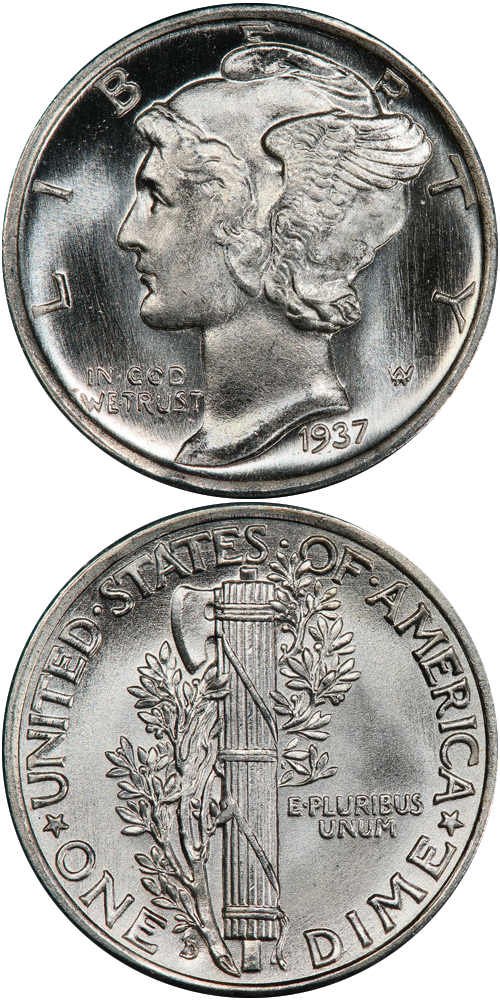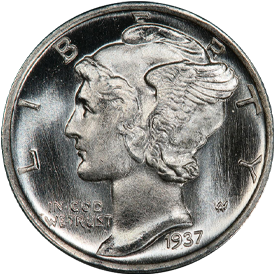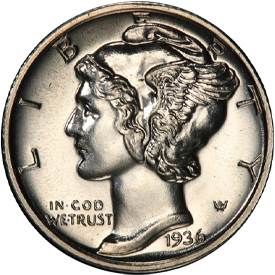Designed by: Adolph A. Weinman
Issue Dates: 1916-1945
Composition: 90% silver, 10% copper
Diameter: 17.9 mm
Weight: 2.50 grams (38.58 grains)
Edge: Reeded
Business Strike Mintage: 2,677,153,880
Proof Mintage: 78,648
In 1916, sculptor Adolph A. Weinman produced a new design for the dime. Called the Liberty Head type at the time, the motif features Miss Liberty facing left, wearing a Phrygian cap with wings, LIBERTY encircling her head, and with IN GOD WE TRUST and the date below. The wings on the cap gave rise to the popular term ''Mercury dime" for the winged messenger. But Mercury was a male in mythology and had wings on his feet. Nevertheless, the name has stuck, and Mercury dimes are what collectors know them as today. The reverse depicts a fasces or bundle of sticks with a blade at the top, against a branch in the background, and with UNITED STATES OF AMERICA and ONE DIME around the border. E PLURIBUS UNUM appears at the lower right. The design was continued without change through 1945. Coinage was accomplished at the Philadelphia, Denver, and San Francisco mints. Proofs were made at Philadelphia from 1936 through 1942.
Examples of the Mercury dime type are readily available in all grades from About Good through superb Uncirculated. Certain issues are lightly struck and are apt to have weaknesses on the bands tying the sticks in the fasces on the reverse. Those with sharply defined bands, designated as "full split bands” are worth more for all issues.
Full Bands
The center horizontal crossband binding the sticks of the fasces on the reverse of the Mercury dime is actually two separate bands. In an effort to prolong die life, mint workers would sometimes slightly increase the spacing between the dies, which resulted in the failure of these center bands to completely strike up. During the 1970s, collectors of Mercury dimes began to show a preference for fully-struck or “split band” dimes, and premiums for these pieces increased. When the third-party grading services began operations in the mid to late 1980s, “FB” or Full Bands were immediately recognized.
If any part of the dividing line between the bands is merged, however small, the coin will not qualify. The line must be complete and unbroken.

Further Reading
The dime design by Charles Barber and issued from 1892 through 1916 was replaced by the Liberty Head motif in 1916. The work of Adolph A. Weinman, an outside (not connected with the Mint) artist, the issue was not intended to represent Mercury, the messenger of mythology with wings on his feet, but to represent an allegorical figure of Miss Liberty with wings on her head, to illustrate "liberty of thought." The design superficially resembled that of Mercury, or at least the public made this connection, so the name has become firmly attached to pieces of this style.
Mercury dimes were minted from 1916 through 1945 without any change in the design. Specimens of the first year of issue, 1916, are often seen with a matte-like surface and with wider borders than are the later issues. The same is true, by the way, of 1916 half dollars (and certain 1917 half dollars as well). This beautiful surface makes coins of the 1916 years exceptionally attractive.
At the outset a rarity was created: the 1916 Denver Mint Mercury dime. Only 245,000 of these were struck. Many 1916 Philadelphia Mint dimes were saved as novelties representing the first year of issue, and the same is true of the 1916-S issues. It would seem reasonable that many thousands of 1916-D would have likewise been saved, but something happened, exactly what I do not know, but the result was that few were saved. Authentic 1916-D dimes in Choice Brilliant Uncirculated condition are really rare!
To continue a few words on this puzzlement, I note that 264,000 1916-D dimes were made, while 52,000 specimens of the new 1916 quarter design representing the Standing Liberty motif were struck. 1916 quarters were saved in quantity, and thousands of Uncirculated pieces exist today. By proportion, perhaps 10,000 to 20,000 Uncirculated 1916-D dimes should exist. But I doubt if more than a few hundred authentic specimens can be traced. In this condition the 1916-D dime is remarkably rare.
The term authentic is an important part of any 1916-D description. Beginning in the 1950s (and, for all I know, extending even before then) a number of persons found that "D" mintmarks can be soldered or otherwise affixed to the reverses of regular 1916 dimes, thus producing forgeries of the 1916-D. Fake 1916-D dimes are undoubtedly one of the most common alterations among mintmark issues of the present century. It pays to be careful when buying one. An established professional dealer is your best protection in this regard. John Jay Ford, Jr., the well-known numismatic scholar, once noted that during a visit to a large convention over half of the "1916-D" dimes he saw were alterations! This is a sad commentary on the chance the uninformed amateur has to acquire an authentic piece, or perhaps it is a sad commentary on the knowledge of certain professionals, or perhaps it is a sad commentary on something else.
Today, the major certification services; PCGS, NGC and ANACS have offered certification of questioned pieces for fee. This has served to quickly halt many such selling activities. I have often thought it would be a good idea to publish the sources from whence such forgeries came, especially if certain firms could be pinpointed as offering a disproportionate number! But, the laws of libel, damaged reputations, and the possibility of so-called "honest mistakes" (but how many honest mistakes can one person make?) have apparently precluded this. But the lesson is clear, and any prospective buyer of a 1916-D Mercury dime should stick strictly to encapsulated pieces.
The 1921 dimes of both the Denver and Philadelphia mints are quite scarce and valuable in all grades. Two overdates occur among Mercury dimes, the 1942/1 and the 1942/1-D. The Philadelphia Mint issue is more distinctive for the undertype 1 is much sharper under the final 2 than it is on the 1942/1-D. Curiously, the 1942/1-D was virtually, if not completely, unknown to numismatists until Frank S. Robinson, a New York numismatist, wrote an article concerning them for the Numismatic Scrapbook Magazine. By that time, it was far too late to secure Uncirculated pieces by scanning 1942-D coins in circulation, so the only Mint State examples known today are those discovered by closely scanning "ordinary" 1942-D pieces.
Beginning in the 1970s a number of numismatists, perhaps following in the footsteps of those who collect Jefferson nickels with full steps, developed a desire to obtain sharply struck Mercury dimes characterized by having the bands on the fasces or bundle of sticks on the reverse sharply separated. Each of the three strips tying the fasces together consist of two thin bands, clearly separated on sharply struck pieces. On weakly struck pieces the strips are fused together, particularly on the highest areas. So called full split bands (abbreviated FSB) dimes are rare for certain issues.
I further note that the term "lightly struck" or "weakly struck" is somewhat of a misnomer. At all times, Mercury dimes (and other coins of the era) were struck with the same amount of pressure, as striking was accomplished by dies actuated by a cam operated from a constantly rotating flywheel. The differences in striking sharpness are explained by the die separation.
If the dies were spaced closely together, then planchets of full weight would be "squeezed" so the metal would completely fill even the deepest die recesses. (Planchets slightly lighter in weight would result in coins with weak striking in the deepest areas in the die, equal to the highest areas of the coin.) However, with such die spacing, dies wore quickly, and the occasional overweight planchet was apt to cause breakage of either a die or the collar, for the metal had nowhere to go. The solution was to space the dies slightly wider apart than the optimum for sharp striking. When this was done, the metal did not completely fill the deepest recesses in the die, including the area of the bands on the reverse. Thus, it can be assumed that at the Philadelphia Mint in 1945, for example, in order to accomplish the tremendous task of minting 159,130,000 Mercury dimes, the Mint personnel were not concerned with producing pieces which were sharply struck. Rather, they wanted to produce the greatest number of coins with the least amount of difficulty, and spacing the dies wider apart meant less frequent die replacement and maintenance.
Mercury dimes are among the most attractive of all coins of the present century. When first issued they inspired many letters to the editor of The Numismatist and other publications. Collectors and dealers alike were lavish in their praise. In Uncirculated grades there are many scarce issues from 1916 through the mid-1920s. Particularly elusive are certain branch mints.
1916-D is the great rarity, as noted, but 1921 and 1921-D, both low mintage issues, are scarce, as are the branch mints of 1924, 1925, 1926, and 1927. Years ago, Joe Block, a dealer, took a fancy to the 1927-D dime, a piece with a mintage not particularly low but which he and certain others considered to be scarce in Uncirculated grade. He told many people of this, and soon his conviction was widely shared. As a result, 1927-D climbed in value sharply above the companion 1927-S, the latter having a lower mintage.
Uncirculated dimes after the late 1920s are encountered with some frequency. A popular way to collect them is to acquire one of each date and mintmark from 1934 through 1945. The overdates are elusive in higher grades. 1942/1 is rare, and 1942/1-D is extremely rare. And, as earlier noted, there are certain issues which are not particularly rarer in various grades, or even in Uncirculated grades, but which with sharp obverse striking and FSB on the reverse are major rarities, the 1925-D, 1926-S, 1927-D, and 1945 being prime examples. Differences in mintmark sizes are known for 1928-S, 1934-D, 1941-S, 1945-S, and probably some other issues as well. The 1945-S with an exceptional small mintmark has been listed in several references. Actually, varying sizes of mintmarks commonly occur throughout United States coinage. As popular albums do not provide spaces for mintmark size differences, only specialists take heed of them.
The Mercury dime was part of a glorious era in American coinage, the revamping of silver designs which occurred across the board in 1916 with the dime, quarter, and half dollar. The Mercury dime, the Standing Liberty quarter, the Liberty Walking half dollar all possess rare beauty and are favorites with collectors today.








